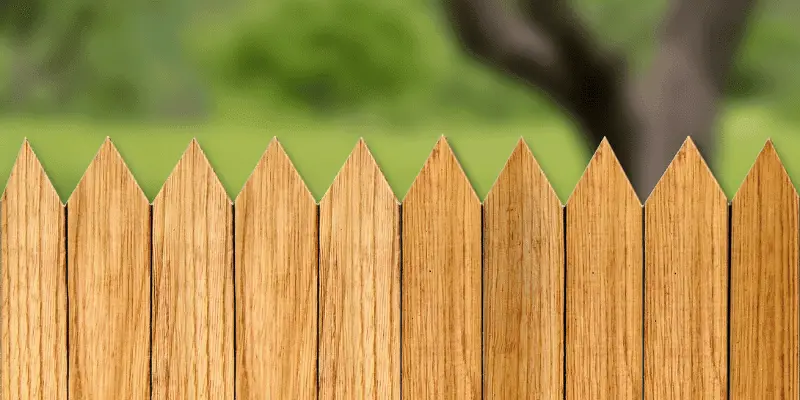When choosing between cedar and redwood for a fence, cedar offers a more cost-effective option with natural insect and rot resistance, while redwood provides a higher level of durability and aesthetic appeal. When deciding between cedar and redwood for your fence, it’s important to consider factors such as cost, longevity, and visual appeal.
Both woods offer unique advantages, and the choice ultimately depends on your specific needs and preferences. Whether you prioritize affordability or long-term durability, understanding the differences between cedar and redwood will help you make an informed decision. In the following sections, we will delve deeper into the characteristics of each wood and how they compare in terms of appearance, maintenance, and environmental impact.
This comprehensive guide will equip you with the knowledge needed to select the ideal material for your fencing project.

Comparing Cedar And Redwood
Cedar and redwood are two popular choices for fencing material due to their natural beauty and durability. Both woods are known for their resistance to rot and insects, making them ideal for outdoor structures. However, each wood has its own unique characteristics that make them suitable for different needs. Let’s take a look at the key differences and similarities between cedar and redwood.
Characteristics Of Cedar
- Natural Resistance: Cedar contains natural oils that act as preservatives, making it resistant to decay and insect damage.
- Affordability: Cedar is generally more affordable than redwood, making it a popular choice for budget-conscious homeowners.
- Color Variation: Cedar has a warm, reddish-brown hue that can vary in tone, adding natural beauty to the fence.
- Durability: While cedar is durable, it may not be as long-lasting as redwood when exposed to harsh weather conditions.
- Workability: Cedar is lightweight and easy to work with, making it an attractive option for DIY projects.
Characteristics Of Redwood
- Natural Durability: Redwood is known for its natural resistance to decay and insects, making it a long-lasting option for outdoor structures.
- Rich Color: Redwood boasts a rich, reddish-brown color that darkens with age, providing a luxurious and timeless appearance.
- Maintenance: Redwood requires minimal maintenance due to its natural resistance to decay, reducing the need for frequent staining or sealing.
- Environmental Impact: Redwood is a sustainable option as it is harvested from managed forests, promoting environmental responsibility.
Pros And Cons Of Cedar Fences
When deciding on the type of fence for your property, cedar fences offer a natural, beautiful option that is both durable and long-lasting. However, it’s important to weigh the pros and cons of cedar fences before making a decision. In this article, we’ll discuss the advantages and disadvantages of cedar fences to help you make an informed choice for your fencing needs.
Advantages Of Cedar Fences
Cedar fences have numerous benefits that make them a popular choice for homeowners. Take a look at some of the advantages of cedar fences:
- Cedar is naturally resistant to rot, decay, and insect infestations, making it a durable option for outdoor use.
- The natural oils present in cedar wood act as a preservative, extending the lifespan of the fence.
- Cedar has a beautiful and distinct grain pattern, adding aesthetic appeal to any property.
- It is lightweight, making it easier to install compared to heavier wood options.
- Cedar is known for its natural aroma that acts as a deterrent to pests.
Disadvantages Of Cedar Fences
While cedar fences offer various advantages, there are also some drawbacks to consider. Here are the disadvantages of cedar fences:
- Cedar is more susceptible to weathering, which can lead to a grayish appearance over time if not properly maintained.
- Although naturally resistant, cedar may still require regular maintenance such as staining or sealing to preserve its appearance and integrity.
- Compared to other wood options like redwood, cedar is generally not as resistant to damage from impact.
- Cedar wood tends to be more expensive upfront compared to some alternative fencing materials.
Pros And Cons Of Redwood Fences
When it comes to choosing the right material for your fence, redwood stands out as a popular choice due to its natural beauty, durability, and resistance to insects and decay. However, it’s important to weigh the advantages and disadvantages of redwood fences before making a decision.
Advantages Of Redwood Fences
Redwood fences offer several compelling advantages that make them an attractive option for homeowners. The natural properties of redwood make it a desirable material for fencing purposes:
- Natural Beauty: Redwood is known for its rich, warm tones and unique grain patterns, adding a touch of elegance to any property.
- Durability: Redwood is naturally resistant to rot, decay, and insect damage, resulting in a longer lifespan compared to many other wood species.
- Low Maintenance: With proper sealing and occasional maintenance, redwood fences can retain their beauty and structural integrity for many years.
- Environmental Benefits: Redwood is a sustainable and eco-friendly option, as it is a renewable resource and requires minimal processing compared to synthetic materials.
Disadvantages Of Redwood Fences
While redwood fences offer numerous advantages, there are a few drawbacks to consider before committing to this fencing option:
- Cost: Redwood is considered a premium wood, so the upfront cost of installation may be higher compared to other wood or synthetic fencing materials.
- Vulnerability to Weathering: Without proper maintenance, redwood can be susceptible to weathering, such as fading and discoloration over time.
- Limited Availability: Redwood is primarily sourced from the Pacific Northwest, so availability might be limited and transportation costs could add to the overall expense.
- Installation Challenges: Redwood is a dense wood, which can make it more challenging to work with during the installation process, potentially leading to higher labor costs.
Choosing The Best Fence For Your Property
When deciding on the type of fence for your property, durability, aesthetics, and maintenance are crucial factors to consider. Both cedar and redwood are popular choices due to their natural beauty and resistance to decay. However, there are key differences in maintenance and longevity that can influence your decision. Let’s examine the factors to consider when choosing between a cedar and redwood fence.
Factors To Consider
Before selecting a fence material, it’s essential to evaluate various factors that can impact its performance and appearance. These factors include:
- Climate and weather conditions
- Budget for installation and maintenance
- Desired aesthetic appeal
- Property location and surroundings
Maintenance And Longevity
Cedar and redwood offer natural resistance to decay, making them low-maintenance fencing options. However, it’s important to consider the long-term maintenance requirements and expected longevity of each material.
Cedar fences require regular maintenance, including staining and sealing, to preserve their appearance and extend their lifespan. On the other hand, redwood is known for its exceptional durability, requiring minimal maintenance over time.
When it comes to longevity, redwood often outperforms cedar, offering a longer lifespan with proper care. It’s crucial to weigh the trade-off between maintenance efforts and the anticipated lifespan when making your decision.
Frequently Asked Questions On Cedar Vs Redwood Fence
What Are The Main Differences Between Cedar And Redwood Fences?
Cedar and redwood are both durable choices for fencing, but cedar is generally more affordable, while redwood has a richer color and is more resistant to rot and insects. Consider your budget and maintenance preferences when choosing between the two.
How Do I Decide Between A Cedar Or Redwood Fence For My Property?
When deciding between these two options, factors such as budget, climate, desired aesthetic, and maintenance requirements should be considered. Evaluate the pros and cons of each material and determine which aligns best with your specific needs and preferences.
Are Cedar Or Redwood Fences More Eco-friendly?
Both cedar and redwood are sustainable choices, but redwood is often considered a more eco-friendly option due to its slower growth and natural resistance to decay. Consider sourcing from certified sustainable suppliers to ensure the environmental friendliness of your choice.
How Long Can I Expect A Cedar Or Redwood Fence To Last?
With proper maintenance, both cedar and redwood fences can last for several decades. However, redwood generally has a longer lifespan due to its natural resistance to decay and insects. Regular maintenance such as staining and sealing can extend the lifespan of either type of fence.
Conclusion
Both cedar and redwood fences offer durability and natural beauty. Depending on your specific needs and budget, either option can be a great choice for your property. Consider the climate and maintenance requirements to make the best decision for a long-lasting and visually appealing fence.



One thought on “Cedar Vs Redwood Fence: Which Is Best for Your Property?”